A poor installation can ruin a project’s reputation. Using the wrong equipment causes visible flaws. The right professional tools are the only way to guarantee a perfect finish.
The essential tools include specialized cutting instruments like Line and Circle Cutters, seaming aids such as Grass Grips and a Glue Fix, and finishing tools like an Edge Trimmer. These guarantee precision, efficiency, and a durable, seamless result that sets professional work apart from amateur attempts.

So, you now have a general idea of the key tool categories. But knowing what they are is one thing; understanding why each one is critical to your business’s success and reputation is another. A great installation makes your project bids more competitive and boosts your profits. Let’s dive deeper into each tool to see how it can transform your installation process from good to great.
What is a Line Cutter and Why Do You Need It?
Cutting straight lines in turf is tough. Wobbly cuts create ugly, weak seams that fail over time. A Line Cutter ensures perfectly straight cuts for flawless, durable seams.
A Line Cutter is a guided cutting tool designed specifically for artificial grass. It allows you to make perfectly straight cuts on the turf backing. This is crucial for creating professional inlay lines or preparing roll edges for seaming. It saves time and prevents material waste.

I’ve seen many installation teams try to use a long ruler and a utility knife. It can work sometimes, but it’s slow and risky. One slip of the hand and you’ve got a crooked cut that will show in the final seam. It looks unprofessional and can even be a weak point in the installation. The Line Cutter solves this problem completely.
How It Works
This tool typically has two plates that you press down on either side of your intended cut line. A guide rail sits between them, creating a perfect channel for your cutting blade. You simply run your knife along this guide. Because the turf is held firmly in place, the blade can’t wander. It’s almost foolproof.
Benefits vs. Manual Cutting
Think about the time saved. For a football field with many lines, this tool can cut down your prep time significantly. More importantly, it delivers consistency. Every cut is identical. This precision is what makes seams disappear after they are glued. It’s a small investment that pays off big in quality and efficiency.
How Does a Circle Cutter Perfect Your Sports Fields?
Free-handing circles on a sports field is nearly impossible. Imperfect circles look amateurish and unprofessional. A Circle Cutter creates perfect circles for center spots and penalty points every time.
A Circle Cutter is an adjustable tool that cuts perfect circles in artificial turf. You set the radius, anchor the tool at the center point, and rotate it to guide the blade. It’s essential for sports fields requiring precise markings like center circles or penalty spots.

I remember a project early in my career where a team tried to cut a center circle using a string and a knife. The result was a wobbly, oval shape that the client immediately pointed out. It was embarrassing and we had to patch it, which never looks as good. That experience taught me the value of a Circle Cutter.
Precision Engineering for Your Field
The tool works like a giant compass. It has a central pivot point that you place at the exact center of your desired circle. An adjustable arm extends from this pivot, holding a blade at the end. You simply set the arm to the correct radius and walk the cutter around the pivot. The blade makes a clean, perfect circular cut.
Why It’s a Non-Negotiable Tool
For any company that bids on sports field projects—football, baseball, or field hockey—this tool is not a luxury; it’s a necessity. The precision it provides is impossible to replicate by hand consistently. It shows your client that you are a professional who invests in the right equipment to deliver a top-quality result. It’s a key to winning more of those high-value sports contracts.
What is a Turf Fix and How Does It Simplify Gluing?
Holding turf edges down while applying glue is awkward. The grass blades get stuck in the glue, creating a messy, weak seam. A Turf Fix tool holds the grass back cleanly.
A Turf Fix, sometimes called a pile-press, is a simple but brilliant tool. It’s a weighted device with pins that holds the turf edges down and parts the grass fibers away from the seam. This prevents glue from contaminating the blades and ensures a clean, strong bond.
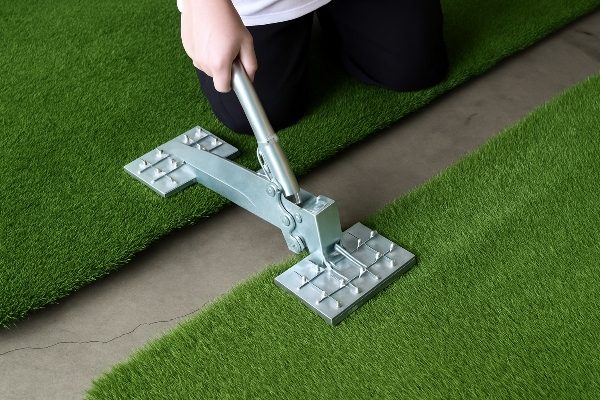
Messy seams are one of the biggest signs of an amateur installation. When grass fibers get trapped in the glue, the seam becomes visible and stiff. It looks bad and the client will complain. The Turf Fix is designed specifically to prevent this common problem.
The Simple Genius of the Tool
It’s essentially a heavy block with combs or spikes underneath. You place one on each side of the seam you’re about to glue. The weight holds the turf carpet flat, while the spikes gently pull the grass blades back and away from the edge. This creates a clear, clean channel right over the seam tape where you can apply your adhesive.
Achieving Invisible Seams
After applying the glue, you work your way down the seam, moving the Turf Fix tools as you go. Once the seam is joined, the grass fibers fall back into place naturally, hiding the join completely. I always tell my clients that if you can easily spot the seam from a standing position, the job wasn’t done right. This tool is your secret weapon for making seams disappear.
Why is a Grass Grip Essential for Tight Seams?
Pulling heavy turf rolls together is back-breaking work. Inconsistent pulling creates gaps or overlaps in the seam. A Grass Grip gives you the leverage to create perfectly tight seams.
A Grass Grip is a powerful seaming clamp. It features sharp teeth that bite into the turf backing, providing a secure hold. An attached handle gives your installers the leverage needed to pull two heavy pieces of turf together tightly and precisely for a perfect, gap-free seam.
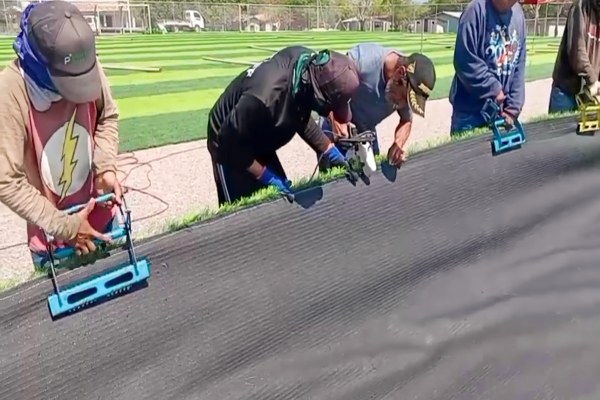
Artificial turf rolls are heavy and difficult to maneuver. Trying to pull two edges together by hand, especially over a long distance, is exhausting and inaccurate. You often end up with small gaps or overlaps that compromise the entire installation. I’ve seen teams of four people struggle to do what two people can do easily with a pair of Grass Grips.
How It Increases Power and Precision
The tool’s design is based on leverage. You clamp one grip onto the edge of each turf roll. The powerful jaws lock onto the backing without damaging it. Then, using ratchet straps or just manual force on the handles, installers can pull the rolls together with incredible control. This allows for micro-adjustments to ensure the seam is perfectly aligned before the glue is applied.
A Table of Benefits
| Feature | Benefit to Your Business |
|---|---|
| Increased Leverage | Less physical strain on your crew, reducing fatigue and risk of injury. |
| Precise Control | Eliminates gaps and overlaps, ensuring a high-quality, professional seam. |
| Faster Seaming | A smaller crew can position rolls more quickly, saving labor costs. |
| Secure Hold | Prevents the turf from slipping during adjustment, reducing errors. |
How Can a Seam Fix Guarantee a Stronger Bond?
Just pressing a seam together by hand isn’t enough. Uneven pressure creates weak spots in the bond that can lift later. A Seam Fix applies consistent, heavy pressure.
A Seam Fix is a specialized pressure roller. After joining the two glued pieces of turf, you run this tool along the seam. Its unique star-shaped wheels apply firm, consistent pressure, forcing the turf backing deep into the adhesive for a maximum strength bond.
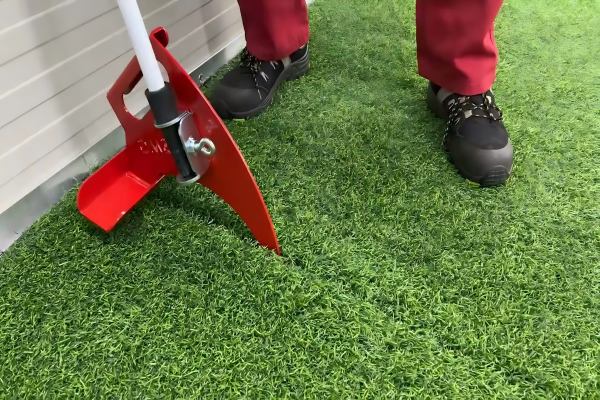
Applying the glue is only half the battle. To get a truly permanent bond, the turf backing needs to be fully embedded into the adhesive on the seam tape. I’ve seen installers try to walk or crawl along the seam to press it down, but this is messy and the pressure is never even. This is where the Seam Fix becomes invaluable.
Designed for a Deeper Bond
Unlike a simple flat roller, the Seam Fix has wheels shaped like stars or gears. As you roll it along the seam, these points concentrate pressure downwards. This action forces any trapped air out and pushes the ribbed backing of the turf firmly into the glue. This mechanical pressing ensures a much stronger and more durable bond than just body weight can achieve.
Preventing Future Problems
A seam that isn’t properly pressed is a ticking time bomb. It might look fine at first, but with foot traffic and changing weather, weak spots can start to lift. This leads to costly callbacks and a damaged reputation. Using a Seam Fix is a simple final step that secures the seam and provides peace of mind for both you and your client.
Can a Glue Fix Make Your Gluing Process Faster and Cleaner?
Applying glue from a bucket is slow and messy. It’s hard to control the amount and thickness, leading to waste and poor bonds. A Glue Fix ensures consistent application.
A Glue Fix is a mobile glue applicator box. You fill it with adhesive, place it on the seam tape, and pull it along the seam. It automatically applies a perfectly consistent, even layer of glue at the correct thickness, dramatically speeding up the process and reducing waste.
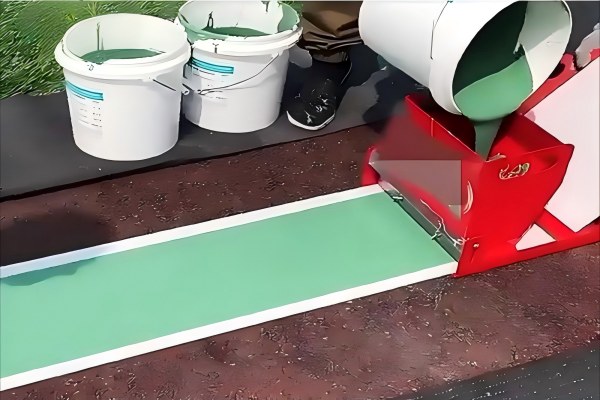
For any large installation, like a full-sized football field, gluing seams by hand with a trowel is a major bottleneck. It’s slow, physically demanding, and it is very difficult to maintain a consistent glue thickness over hundreds of meters. Too little glue and the bond fails; too much glue and it oozes out, making a mess. The Glue Fix solves all of these issues.
The Mechanics of Efficiency
Think of it as a moving hopper for your glue. It’s a box on wheels that you position directly on the seam tape. You can adjust a gate on the back to control the flow and thickness of the adhesive. As your installer pulls the box forward, it lays down a perfect ribbon of glue. No more kneeling, no more scooping from a bucket.
Key Advantages for Your Business
The benefits are obvious: it’s much faster, saving huge amounts of labor time. It’s cleaner, as the glue is contained within the box. And most importantly, it’s consistent. This consistency ensures every inch of your seam has the optimal amount of adhesive for the strongest possible bond. It’s a tool that pays for itself very quickly in saved time and materials.
What Makes a Specialized Grass Cutter Better Than a Standard Knife?
Standard utility knives dull quickly on turf backing. A dull blade tears the turf instead of cutting it, leading to a frayed, unprofessional finish. A Grass Cutter is built for the job.
A Grass Cutter is a heavy-duty cutting tool designed for artificial turf. It can be a simple, ergonomic handle that holds special hooked or straight blades. These tools use stronger, sharper blades that slice cleanly through tough backing without tearing.
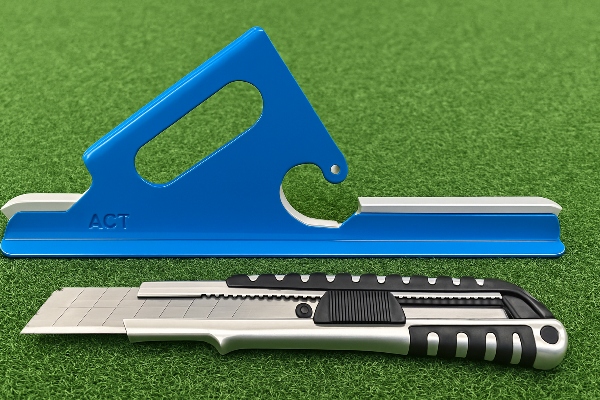
Turf backing is incredibly tough. It’s a composite of latex, polyurethane, and woven polypropylene. A standard Stanley knife blade will become dull after just a few meters of cutting. A dull blade doesn’t just make the work harder; it rips and tears the backing fibers. This creates a weak, frayed edge that is difficult to seam properly.
Choosing the Right Blade for the Job
Professional grass cutters use blades made from higher-grade steel that hold an edge for much longer. There are two main types:
- Hooked Blades: These are great for cutting from the top side of the turf. The hook gets under the backing and slices upwards, avoiding damage to the grass fibers.
- Straight Blades: These are typically used with tools like the Line Cutter and are best for cutting from the back side for maximum precision.
Having a dedicated Grass Cutter and a good supply of sharp, high-quality blades is fundamental. I always advise crews to change their blades frequently. A sharp blade means less effort, safer cutting, and a much cleaner, more professional result.
How Does an Edge Trimmer Create that Perfect Final Finish?
Trimming turf against a hard edge like a curb is tricky. It’s easy to cut too much or too little, leaving gaps or a messy overlap. An Edge Trimmer makes it simple.
An Edge Trimmer is a specialized tool that guides your blade perfectly along a hard border, like a concrete curb or paver edge. It ensures a precise, clean cut every time, creating a flawless transition between the turf and its surrounding elements.
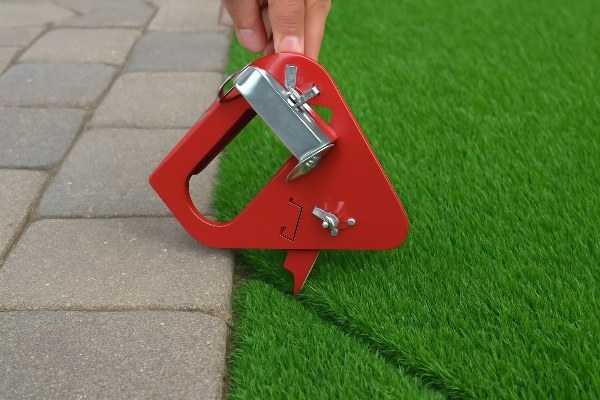
The perimeter of your installation is what everyone sees up close. A ragged edge immediately cheapens the look of the entire project. Trying to trim this edge with a freehand knife is one of the most common mistakes I see. It’s very difficult to maintain a consistent line, especially on curved edges. The Edge Trimmer is the tool designed to master this final, critical step.
Simple Design, Flawless Results
The tool usually has a guide plate that rests against the hard edge you are cutting against. This guide holds the cutting blade at a fixed, precise distance from the edge. As you slide the tool along the curb or wall, the blade makes a perfect cut in the turf. It can cut the turf to be exactly flush with the edge, or leave a small amount to be tucked, depending on the tool’s design.
Where It Shines
This tool is essential for landscape projects with garden edging, patios, and walkways. It’s also a must-have for creating professional putting greens, allowing for a perfect cut around the cup. It’s one of those finishing tools that separates the true professionals from the rest.
Why is a Floor Test the Most Important First Step?
Installing on a bad sub-base guarantees failure. Uneven or poorly compacted ground will cause sinking and drainage issues later. A Floor Test tool checks the base before you start.
A Floor Test tool, such as a Clegg Hammer or a Dynamic Cone Penetrometer (DCP), measures the compaction and stability of the sub-base. It tells you if the foundation is solid enough to support the turf installation and withstand use without sinking or shifting over time.

The best artificial turf and the most skilled installation will fail if the foundation is bad. The sub-base is everything. I cannot stress this enough. If it’s not properly compacted and leveled, you will get dips, puddles, and uneven surfaces within months. A Floor Test tool is your insurance policy against this. It’s not about the turf itself, but the ground underneath.
Understanding the Data
These tools provide objective data about the ground’s condition. For example, a Clegg Impact Soil Tester measures the hardness (or "G-max") of the surface. A DCP test measures the strength of different layers beneath the surface. This isn’t guesswork; it’s science. The data tells you if the contractor who prepared the base did their job properly or if more compaction is needed before you lay a single roll of turf.
Protecting Your Reputation (and Your Wallet)
As an installer, signing off on a bad sub-base makes you responsible for the failure. When the field starts to sink, the client will call you, not the earth-moving contractor. By performing and documenting a floor test before you start, you protect yourself. If the base fails the test, you can demand it be fixed before you proceed. This simple step can save you from catastrophic failures and protect your company’s reputation for quality.
Conclusion
Investing in these professional tools is not an expense. It is a direct investment in your company’s quality, efficiency, and reputation, leading to greater profits and more successful projects.
_画板-1.png)
_画板-1.png)